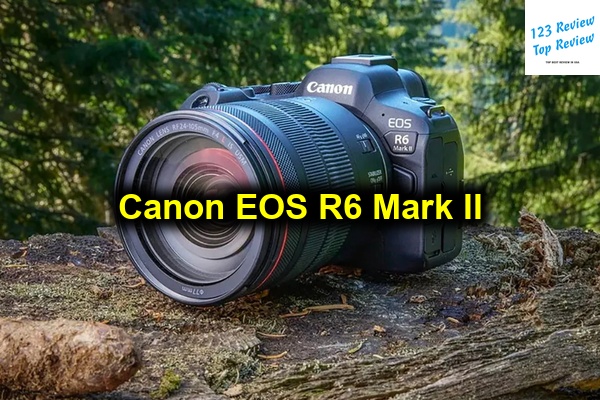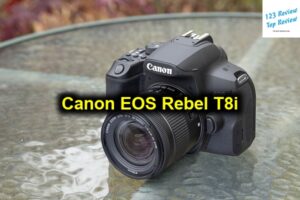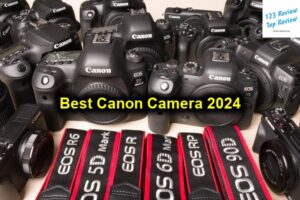The Canon EOS R6 Mark II is a thrilling addition to Canon’s expanding lineup of mirrorless cameras, aimed at diverse users spanning professional photographers, enthusiastic hobbyists, and dedicated videographers. This camera builds on the innovative groundwork laid by its predecessor, the R6, offering improvements and fine-tuned features that elevate its overall performance. With exceptional image quality, advanced autofocus, and comprehensive video capabilities, the R6 Mark II promises to meet the increasingly complex demands of modern visual storytellers.

In this article, 123 Review review will unpack its features, performance, design, and usability, providing a thorough analysis for prospective buyers.
Features and Specifications
Sensor and Image Quality
At the heart of the Canon EOS R6 Mark II is a new 24.2-megapixel full-frame CMOS sensor, an improvement from the previous model’s 20.1-megapixel sensor. This increase in resolution delivers enhanced detail and clarity, catering to photographers who need flexibility for cropping and high-resolution outputs. Paired with the powerful DIGIC X image processor, the sensor maintains Canon’s reputation for producing images with rich, vibrant colors and extensive tonal range.
The camera offers an ISO range from 100 to 102,400, expandable to 204,800, providing remarkable performance in various lighting conditions. This wide range ensures that users can capture images with minimal noise, even in challenging low-light environments, which is crucial for event photographers or those who frequently shoot in dimly lit venues. The R6 Mark II also excels in dynamic range, skillfully capturing shadow and highlight details even in high-contrast scenes.
Autofocus System Enhancements
Canon has significantly upgraded the autofocus capabilities of the R6 Mark II, equipping it with the sophisticated Dual Pixel CMOS AF II system. This advanced autofocus system offers 1,053 selectable AF points, offering nearly complete frame coverage for precise focusing and the ability to track subjects effectively across the entire viewfinder.
One of the most impressive features is the integration of Deep Learning technology, which enhances subject recognition and tracking accuracy. This includes improved face, eye, and animal detection, as well as an innovative mode for vehicle tracking, making it highly versatile for various photography genres. The camera’s ability to sustain focus on fast-moving subjects in both stills and video modes is particularly beneficial for sports and wildlife photographers.
Video Capabilities
The Canon EOS R6 Mark II shines in the realm of videography, providing a substantial toolkit for creators. It supports 4K video recording at up to 60fps with no crop, allowing for full sensor readout and ensuring high-quality, detailed footage. For creators inclined towards slow-motion content, the R6 Mark II can capture Full HD at up to 120fps, offering smooth and dynamic slow-motion effects.
Moreover, the camera includes a range of professional video features such as Canon Log 3 and HDR PQ for greater latitude in post-production. These features enable videographers to capture footage with expansive dynamic range, making it ideal for high-end film production. The inclusion of dual memory card slots supports uninterrupted recording, essential for capturing extended footage during shoots.
Performance Analysis
Burst Shooting Rates
The Canon EOS R6 Mark II is designed for action, featuring impressive burst shooting capabilities. It can achieve up to 20fps with the electronic shutter and 12fps with the mechanical shutter. This rapid shooting is especially advantageous for capturing high-energy scenes, such as sports events or wildlife movements, where timing and precision are critical.
The improved buffer capacity ensures that photographers can take full advantage of these burst rates without experiencing delays due to data processing limitations. This capability allows professionals to reliably capture fleeting moments, providing a seamless shooting experience even during high-paced assignments.
Low-Light Performance
Low-light performance is a standout feature of the R6 Mark II, made possible by the synergy between its sensor and DIGIC X processor. The camera’s ability to handle high ISOs with minimal noise makes it a reliable tool for challenging lighting environments. In real-world shooting scenarios, such as concerts, theater performances, or night photography, the R6 Mark II demonstrates its prowess by maintaining excellent image fidelity, depth, and color accuracy.
Additionally, the autofocus system retains its speed and accuracy in low-light situations, ensuring that subjects remain in focus even under difficult lighting conditions. This reliability is crucial for photographers who cannot always rely on external lighting, such as wedding photographers capturing spontaneous, intimate moments.
Image Stabilization
The in-body image stabilization (IBIS) of the R6 Mark II is a key feature, providing up to 8 stops of stabilization. This advanced system allows for handheld shooting in various lighting conditions, reducing camera shake and resulting in sharper images without requiring a tripod. This stabilization is also exceptionally beneficial for video recording, ensuring smooth footage across all shooting environments, and reducing the need to carry additional stabilization equipment.
For photographers and videographers on the go, especially those documenting travel, landscapes, or handheld events, the IBIS proves vital, allowing for creative freedom and reliability in capturing high-quality content without compromise.
Usability and Design
Ergonomics and Build Quality
Canon has designed the EOS R6 Mark II with ergonomics in mind, ensuring it feels balanced and comfortable during extended use. The body of the camera is crafted from magnesium alloy, offering a robust construction that withstands the rigors of daily use and travel. Despite its sturdy design, the camera remains lightweight, making it easy to carry for long periods—ideal for fieldwork or travel photographers.
The inclusion of extensive weather sealing around the buttons and ports adds another layer of durability, safeguarding the camera from dust, moisture, and challenging weather conditions. This rugged design is perfect for adventure photographers or those who frequently shoot in unpredictable environments.
Menu Interface and Controls
A user-friendly interface is crucial for navigating complex settings quickly, and Canon delivers with the R6 Mark II. The camera’s menu system is renowned for its ease of use, featuring a logical layout that facilitates intuitive navigation for both new users and experienced photographers familiar with Canon’s menu structure.
The camera also offers customizable buttons and a robust touchscreen interface, allowing users to tailor the camera’s settings to their personal workflow. This flexibility ensures quick access to frequently used functions and settings, significantly enhancing the shooting experience in fast-paced or fluid environments where time is of the essence.
Battery Life and Connectivity
The Canon EOS R6 Mark II is powered by the LP-E6NH lithium-ion battery, offering impressive battery life. Users can expect approximately 510 shots per charge when using the electronic viewfinder, and more when using the rear LCD screen for compositions. This enhanced battery performance supports long shooting sessions, though carrying additional batteries is recommended for extended video shoots or events.
Connectivity options are comprehensive and include built-in Wi-Fi and Bluetooth for seamless integration with smart devices. This capability allows photographers to transfer images directly to their devices, facilitate wireless shooting, and even perform remote control operations via the Canon Camera Connect app. Additionally, the camera supports USB-C charging and a direct HDMI output, enabling easy connections to external devices for viewing or extended power during intensive sessions.
Pros and Cons
Advantages of the Canon EOS R6 Mark II
- Enhanced Dual Pixel CMOS AF II System: Offers fast, accurate focusing with complete frame coverage and improved subject tracking.
- Superb Image Quality: The 24.2MP sensor and DIGIC X processor deliver sharp, vibrant images with excellent dynamic range.
- Professional Video Capabilities: Supports 4K 60fps recording with Canon Log 3 and HDR PQ, ideal for high-quality video production.
- Stabilization Excellence: Up to 8 stops of IBIS enhances the capability for handheld shooting and smooth video capture.
- Solid Construction and Design: Weather-sealed magnesium alloy body ensures durability and reliability across various conditions.
Limitations and Drawbacks
- Premium Pricing: The R6 Mark II’s advanced features come with a higher price point, potentially limiting accessibility for beginners or budget-conscious users.
- Subtle Upgrades over R6: While enhanced, some users may not find the differences over the R6 significant enough to warrant an upgrade.
- Battery Consumption in Video Mode: Extended video sessions may require additional battery resources, meriting extra consideration for videographers.
Comparison with Competitors
Canon EOS R6 vs. R6 Mark II
Compared to its predecessor, the Canon EOS R6 Mark II introduces several enhancements, most notably the increased sensor resolution, which provides greater detail and flexibility for post-processing. The autofocus system has also been bettered with more sophisticated subject tracking, resulting in higher accuracy, especially for specific subjects like animals and vehicles.
The R6 Mark II also offers more refined video capabilities with new features like Canon Log 3, allowing for greater creativity and grading opportunities. While both models deliver excellent performance, the Mark II’s updates make it more appealing to professionals seeking cutting-edge features.
Comparison with Sony a7 IV
The Sony a7 IV is a strong competitor, offering a 33-megapixel sensor that provides higher resolution and potential for cropping. It also features Sony’s acclaimed autofocus system and strong video performance. However, the Canon R6 Mark II surpasses in terms of image stabilization, offering more stops of stabilization, and providing a more tactile and traditional DSLR-like usability favored by some users.
While both excel in dynamic range and low-light performance, the choice may ultimately hinge on personal preference regarding ergonomics, user interface, and brand-specific color science, with Canon traditionally known for warm and accurate skin tones.
Alternatives to Consider
Photographers considering the Canon EOS R6 Mark II might also evaluate:
- Nikon Z6 II: Offers great video functionality and excellent build quality, appealing to hybrid shooters.
- Panasonic Lumix S5: Known for handling and video prowess, it’s a great option for videographers.
- Fujifilm X-T5: Provides unique styling and film simulation modes within an APS-C sensor, catering to artistic photographers seeking portability and creative effects.
Each alternative brings distinctive strengths in sensor technology, control layouts, and personalized styling options, appealing to different user preferences and photographic styles.
Conclusion and Recommendations
Ideal User Scenarios
The Canon EOS R6 Mark II is tailored for photographers and videographers who demand robust performance, versatility, and adaptability in diverse shooting conditions. Appealing particularly to professionals in event photography, sports, wildlife, and wedding coverage, this camera offers precision and efficiency. Videographers will also find the extensive video features beneficial for producing high-quality content for film, commercial, and online platforms.
Final Thoughts on the Canon EOS R6 Mark II
In the ever-evolving realm of mirrorless technology, the Canon EOS R6 Mark II stands out by enhancing key attributes that support both photography and video production. Its sophisticated autofocus, stabilization, and superb image quality meet professional standards, justifying its position as a premium investment for serious users. Though priced at a premium, the combination of advanced technology and user-friendly design ensures it remains a top choice for content creators striving for excellence.
The R6 Mark II successfully integrates technological innovation with traditional photographic values, embodying a tool fully capable of capturing the aspirations and visions of today’s storytellers. Whether you’re upgrading from a previous model or entering the world of mirrorless photography, this camera offers the features and flexibility to push creative boundaries and achieve professional-level results.





